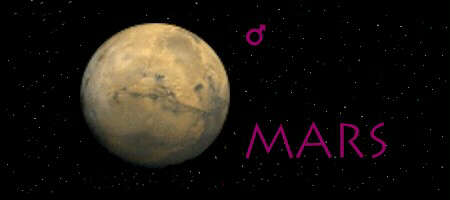|
|
|

|
Mars is the fourth planet from the Sun and the seventh largest. In Roman mythology Mars was the god of war. Phobos is the larger and innermost of Mars' two moons, but one of the smallest in the solar system. In Greek mythology Phobos was the personification of fear and terror. Deimos is the smaller and outermost of Mars' two moons, and the smallest known moon in the solar system. In Greek mythology Deimos personified dread.
Mars was known to the Ancients as the "Lesser Malefic", a negative influence and a harbinger of strife, turmoil, accidents, and general misfortune. The modern astrologer regards Mars as representing initiative and energy, the aggressive principle, how you go after what you want. The urge to do, to go, to MOVE, that is Mars. Where it is found, is where you expend the greatest energy. . . where your initiative is channeled.
As the traditional ruler of Aries (and Scorpio to the Ancients), it is the masculine and sexual side of love, strength and courage or destructive fighting. Without Mars, we would never accomplish anything as he provides the initiative to go forward, even against impossible odds.
Physically, Mars rules the muscular system, external reproductive organs, head and face, red blood corpuscles, motor nerves, bladder, and the adrenal glands.
For colors, gemstones, and metals, Aries is associated with bright red, gold, and deep blue; the gem of diamond; and the metal iron.
![]()
![]() Astronomical
data:
Astronomical
data:
Mars is more like Earth than any other object in our solar system, although it is only half as large. It has mountains and valleys, volcanoes and earthquake faults, dry river beds and polar ice caps. It has an atmosphere with clouds, winds, and dust storms; it has summer and winter seasons; its surface is solid and composed mainly of silicon dioxide (sand); and its temperature is moderate by astronomical, if not, human, standards. Consequently, it is the only place beyond the Moon that we can seriously consider visiting.
The volcanoes erupting over billions of years have built up mountains that dwarf any on Earth. Its polar caps are composed mainly of carbon dioxide ice, but the northern cap evaporates in the summer, leaving a smaller cap containing only water ice. The composition of the soil is about one-fifth ferric oxide (rusty iron) which accounts for the red color of both the surface and the sky. In the Martian springtime the surface of the planet changes color due to seasonal winds covering and uncovering darker surfaces of reddish dust.
Mars has two small moons - Phobos is the larger and zips around Mars in only 7 1/2 hours. Deimos, the smaller moon, takes 30 hours to orbit.
[Sun] [Moon] [Mercury] [Venus] [Mars]
[Jupiter] [Saturn] [Uranus] [Neptune] [Pluto]
*Astrological Backgrounds Menu*
![]()
Planet Index ||| Astro Resources
Interests
& Hobbies & Links, Oh My!
Critters! Siteguide